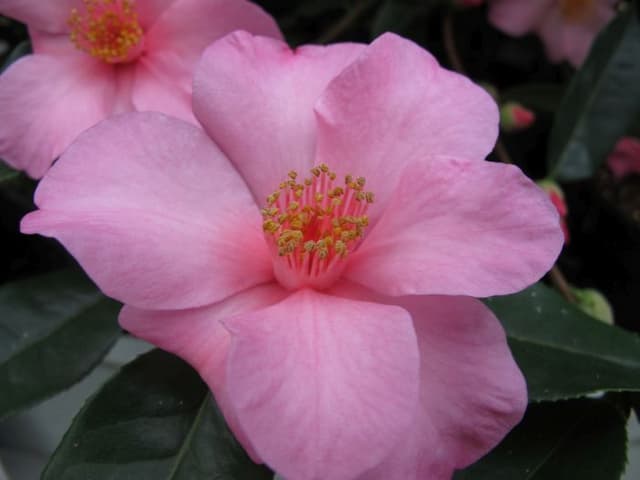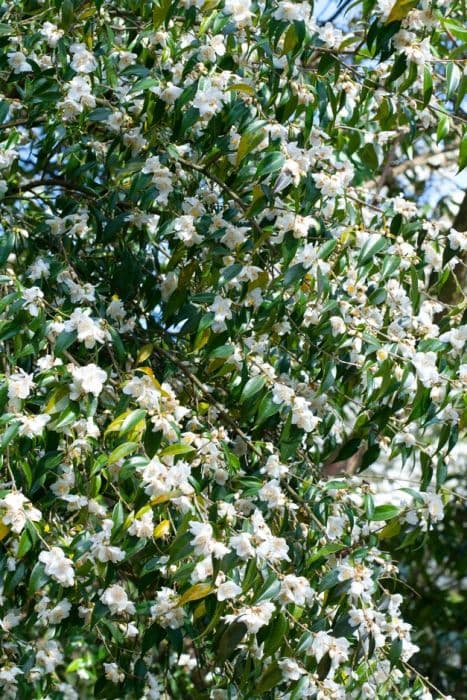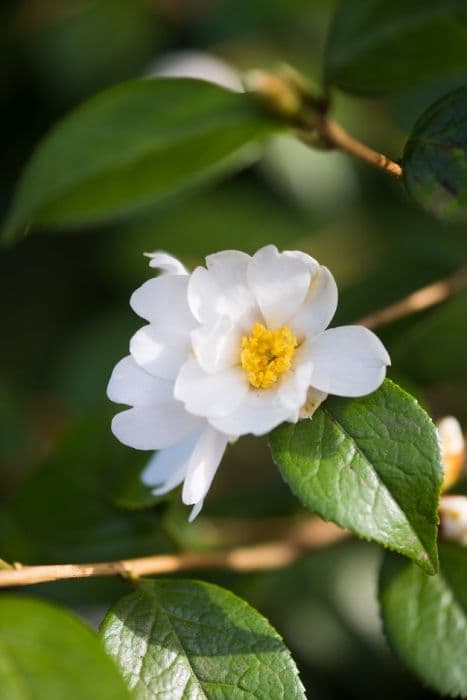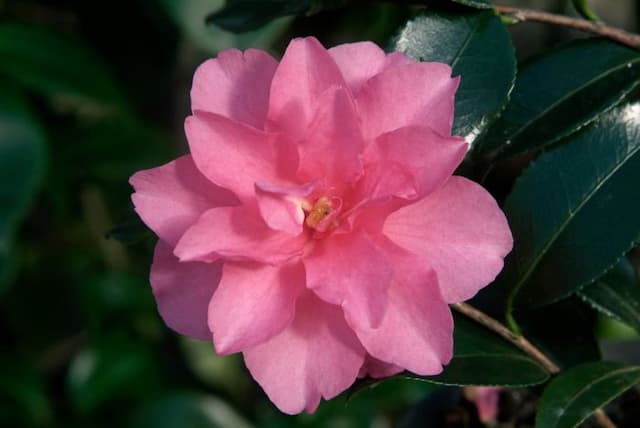Williamsii Camellia Camellia × williamsii 'Daintiness'

ABOUT
The Camellia 'Daintiness' is a visually striking plant that is noted for its graceful features. It showcases an evergreen foliage, which means it retains its glossy, dark green leaves throughout the year, providing a constantly verdant appearance. The leaves typically have a leathery texture, presenting an elegant backdrop for the flowers. When in bloom, 'Daintiness' exhibits an abundance of delicate flowers that tend to have a light pink hue, with slightly deeper pink shades elegantly distributed along the petal edges. The flowers are characteristically semi-double, meaning they have two or more rows of petals but are not as full as fully double blooms. This gives the flowers a sense of depth and texture while maintaining an airy, unfussy look. The petals are often arranged in a slightly overlapping fashion which adds to the plant’s charming display. In the center of each flower, there is a prominent and showy spray of bright yellow stamens, which contrasts beautifully with the pink petals and serves as an attractant to pollinators. Overall, the aesthetic appeal of Camellia 'Daintiness' is in its blend of simple elegance and romantic appeal. It is a plant that is favored for its classic beauty and its ability to bring a touch of sophistication to any garden setting. Its floral display is typically most pronounced in the winter to spring months, adding color and interest to the garden when many other plants are dormant.
About this plant
 Names
NamesFamily
Theaceae.
Synonyms
Williams' Camellia, Hybrid Camellia.
Common names
Camellia × williamsii 'Daintiness'.
 Toxicity
ToxicityTo humans
The Camellia, specifically the Camellia × williamsii 'Daintiness', is generally considered non-toxic to humans. Ingesting parts of this plant typically does not lead to poisoning or serious health consequences. It is always advisable to avoid eating ornamental plants due to potential pesticide contamination, but the Camellia itself is not known to inherently contain substances dangerous to human health.
To pets
The Camellia, including the variety Camellia × williamsii 'Daintiness', is not known to be toxic to pets. It is not associated with any significant poisoning risks if pets were to ingest parts of the plant. However, as with all non-food plants, ingestion can sometimes cause mild gastrointestinal upset, such as vomiting or diarrhea, especially if eaten in large quantities. It is generally best to keep ornamental plants out of reach of pets to avoid any potential issues.
 Characteristics
CharacteristicsLife cycle
Perennials
Foliage type
Evergreen
Color of leaves
Dark green
Flower color
Pale pink
Height
6-10 feet (1.8-3 meters)
Spread
5-8 feet (1.5-2.4 meters)
Plant type
Shrub
Hardiness zones
7
Native area
Japan China
Benefits
 General Benefits
General Benefits- Aesthetic Appeal - Camellia × williamsii 'Daintiness' is known for its beautiful pink flowers that bloom in the spring, adding color and visual interest to gardens.
- Year-Round Foliage - This plant maintains its glossy, evergreen leaves throughout the year, providing a constant backdrop of greenery.
- Durability - It has a robust nature, being relatively drought-tolerant and able to withstand various growing conditions once established.
- Pollinator Attraction - The flowers can attract pollinators such as bees, which are essential for the health of the ecosystem.
- Versatility in Landscaping - Suitable for borders, specimen planting, and woodland gardens, it offers various options for garden design.
- Privacy Screen - When planted in groups, Camellia × williamsii 'Daintiness' can serve as an attractive privacy screen or hedge.
- Low Maintenance - Requires minimal pruning and is relatively pest and disease resistant, making it an easy-care option for gardeners.
 Medical Properties
Medical PropertiesThis plant is not used for medical purposes.
 Air-purifying Qualities
Air-purifying QualitiesThis plant is not specifically known for air purifying qualities.
 Other Uses
Other Uses- Camellia williamsii 'Daintiness' can be used in bonsai cultivation, where it is appreciated for its beautiful flowers and the challenge it presents to bonsai artists due to its woody structure and foliage.
- The petals of this Camellia can be used to adorn table settings or floating in bowls of water as a decorative element during special events and ceremonies.
- Its leaves can serve as a natural dye source for fabrics, offering hues ranging from green to brown depending on the mordant used.
- The blossoms can be used to make a fragrant and colorful infusion for use in soaps, giving them a delicate floral scent and visual appeal.
- Camellia williamsii 'Daintiness' is sometimes used as a symbol in floral arrangements for weddings or other events, representing adoration or perfection.
- Dried and pressed flowers or leaves of the plant can be used in crafting, such as in making bookmarks, cards or in scrapbooking for an elegant touch.
- Photographers and artists may use this variety of camellia as a subject for its aesthetic qualities, capturing its distinctiveness in various mediums.
- The plant's branches and foliage can be incorporated into wreaths and other decorative greenery for festive occasions.
- Extracts from the flowers can be used in perfumery, capturing the delicate scent to be used in creating custom fragrances.
- Culinary enthusiasts sometimes crystallize Camellia williamsii 'Daintiness' petals to create edible decorations for cakes and desserts.
Interesting Facts
 Feng Shui
Feng ShuiThe Camellia is not used in Feng Shui practice.
 Zodiac Sign Compitability
Zodiac Sign CompitabilityThe Camellia is not used in astrology practice.
 Plant Symbolism
Plant Symbolism- Admiration - The camellia is often associated with admiration, reflecting the beauty and perfection of the bloom.
- Perfection - Camellias represent the ideal, often used to convey the message of someone or something being flawless.
- Love - Camellias have long been a symbol of love, especially deep, passionate love between partners.
- Affection - The camellia, with its soft, delicate petals, is emblematic of genuine affection and warmth towards another.
- Longevity and Faithfulness - Because the camellia blooms for a long time and consistently, it's associated with the endurance of love and relationships.
- Devotion - This plant indicates strong dedication and commitment, often in a romantic context.
 Water
WaterWilliamsii camellias, including 'Daintiness', prefer consistently moist soil that is never waterlogged. During the growing season, water the plant deeply once a week, making sure to moisten the soil thoroughly each time. This might mean providing about 1 to 1.5 gallons of water for a medium-sized shrub, depending on the weather and soil conditions. During hot, dry spells, you may need to water more frequently, while in cooler or rainy periods, water less often. Always check the soil moisture at a depth of a few inches; if it feels dry, it's time to water again.
 Light
LightWilliamsii camellias thrive in partial shade, where they can be protected from the harsh midday sun. Ideally, plant 'Daintiness' in a location that receives filtered sunlight or morning sun with afternoon shade. This gentle lighting condition mimics the camellia's natural habitat beneath forest canopies and helps maintain the vibrant colors of its delicate blooms.
 Temperature
TemperatureWilliamsii camellias, such as 'Daintiness', do best in moderate climates where temperatures rarely drop below 20°F or soar above 85°F. As a rule, maintain a temperature range of 40°F to 70°F for optimal growth and flowering. Camellias are hardy in USDA Zones 7 to 9 and can tolerate brief periods of colder temperatures, but prolonged exposure to extremes can be damaging.
 Pruning
PruningPruning Williamsii camellias like 'Daintiness' should be done to maintain shape, remove dead or overcrowded branches, and encourage vigorous growth. The best time to prune is just after blooming, which for 'Daintiness' is typically in late winter or early spring. Cut back unwanted branches and thin out dense areas annually, using clean, sharp tools to make precise cuts and minimize any damage to the plant.
 Cleaning
CleaningAs needed
 Soil
SoilThe Camellia Williamsii 'Daintiness' thrives in acidic soil with a pH between 5.0 and 6.5. The best soil mix is well-draining and rich in organic matter. A mix of one-third peat moss, one-third perlite or vermiculite, and one-third pine bark or ericaceous compost is ideal for this camellia.
 Repotting
RepottingCamellia Williamsii 'Daintiness' should be repotted every 2 to 3 years, preferably in the spring. The frequency of repotting depends on the plant's growth rate and the size of the container; repot when the plant becomes root-bound.
 Humidity & Misting
Humidity & MistingCamellia Williamsii 'Daintiness' prefers a humidity level of 40-60%. Consistently high humidity is beneficial for this plant, but it can tolerate lower levels if not subjected to dry heat sources.
 Suitable locations
Suitable locationsIndoor
Keep in bright, indirect light and high humidity.
Outdoor
Plant in partial shade, shelter from strong winds.
Hardiness zone
7-9 USDA
 Life cycle
Life cycleCamellia × williamsii 'Daintiness', commonly known as Camellia, starts its life as a seed, which, when planted in well-draining, acidic soil and given the right conditions of partial shade, will germinate. The seedling stage follows, characterized by the emergence of the cotyledons and then true leaves, as it establishes itself. Next is the vegetative stage where the Camellia grows stems, leaves, and roots as it matures, which can last for several years, during which it requires consistent moisture and protection from direct sun. Flowering occurs typically in late winter to early spring, depending on the local climate; 'Daintiness' produces delicate pink flowers that attract pollinators. After pollination, it will produce seed capsules, and once these mature, they release seeds to start a new generation. This evergreen shrub can live for many years, sometimes over a century, with proper care, including regular pruning to maintain shape and encourage new growth.
 Propogation
PropogationPropogation time
Spring-Early Summer
Propogation: Camellia × williamsii 'Daintiness', often known as hybrid camellia, is commonly propagated through semi-hardwood cuttings. This is typically done in late summer, after the blooms have faded and the new growth has started to mature. To propagate by cuttings, a gardener would select healthy, semi-hardwood stems about 4 to 6 inches long, with several sets of leaves. The lower leaves are removed and the cut end is dipped in rooting hormone to encourage root development. Then, the cutting is planted in a well-draining potting mix, maintaining high humidity and steady temperatures of about 70 to 75 degrees Fahrenheit (21 to 24 degrees Celsius). It's crucial to keep the soil consistently moist but not waterlogged. Roots usually develop within a few months, after which the new camellia plant can be gradually acclimated to less humid conditions before being transplanted outdoors.









